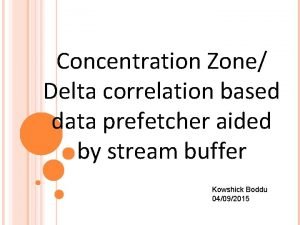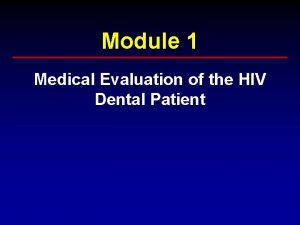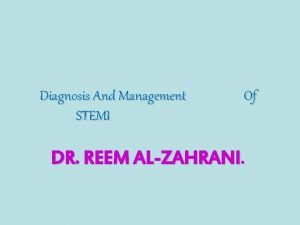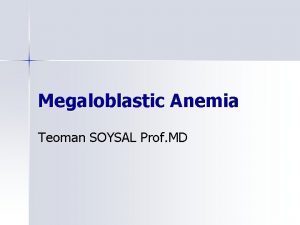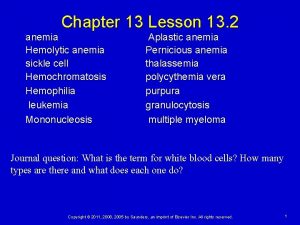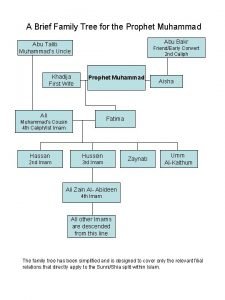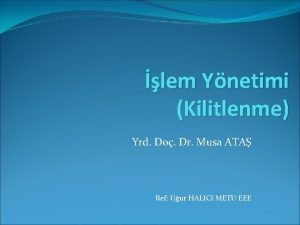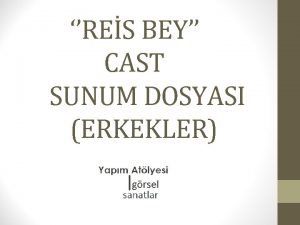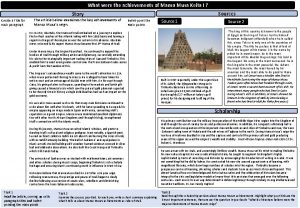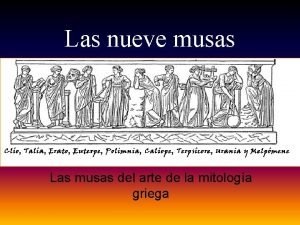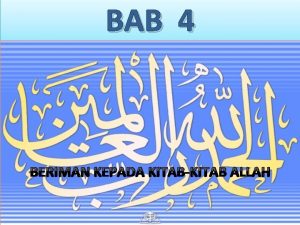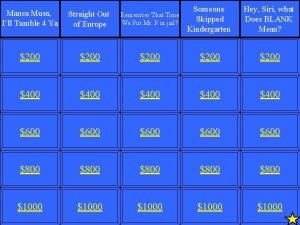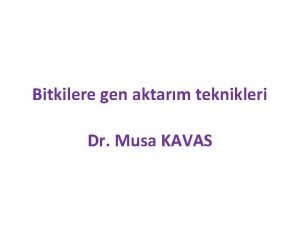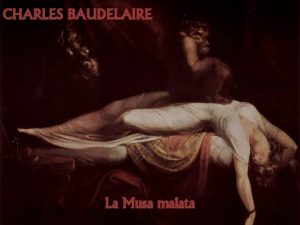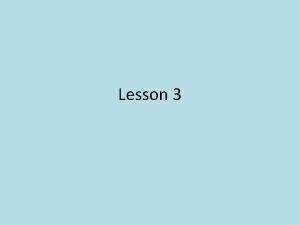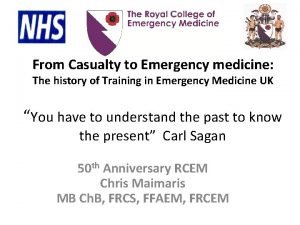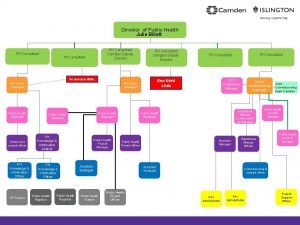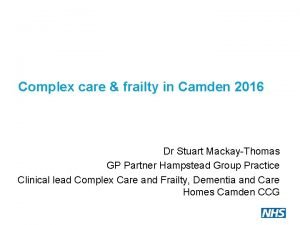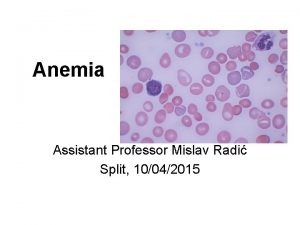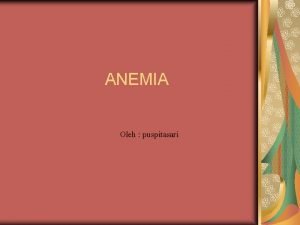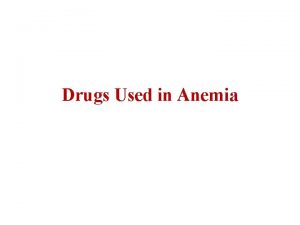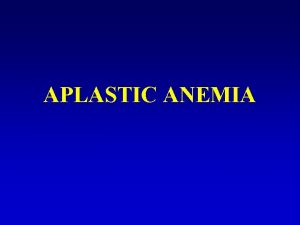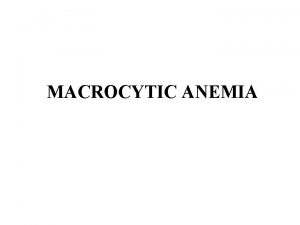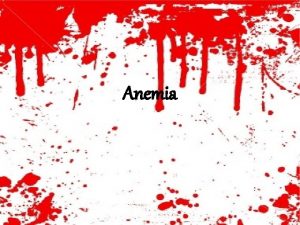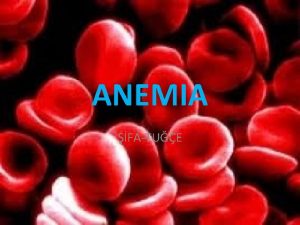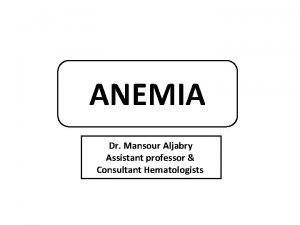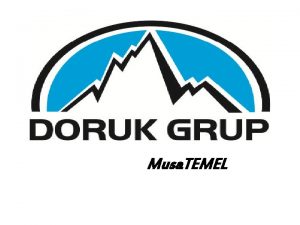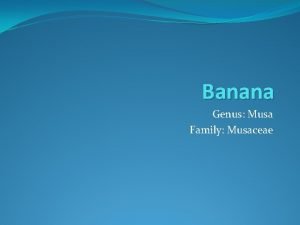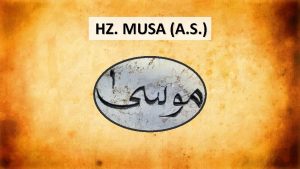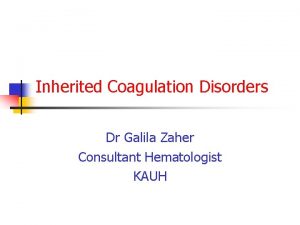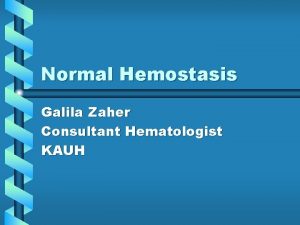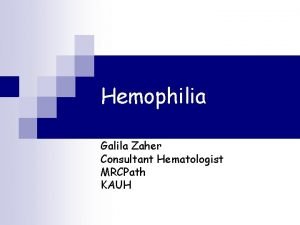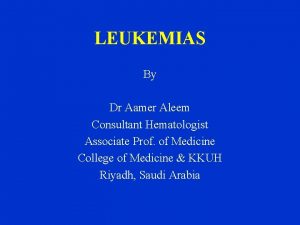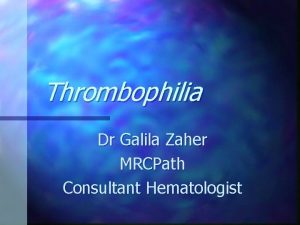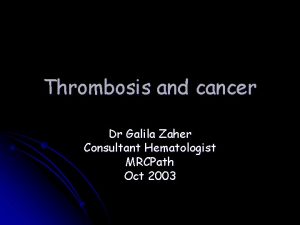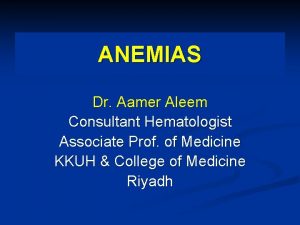Anemia Dr Musa Alzahrani Assistant Professor Consultant Hematologist























































- Slides: 55

Anemia Dr. Musa Alzahrani Assistant Professor Consultant Hematologist MBBS, FRCPC, ABIM, MHSc

Objectives • Know how to read a CBC (complete blood count) • Approach to common causes of anemia • Understand the common terminologies • Brief overview of investigations and management

RBCs

What keep them biconcave?

Terminology: spherocytosis Loss of central pallor Central pallor 1/3 rd

elliptocytosis

Schistocytes (Helmet cells)

Thrombotic thrombocytopenic purpura (TTP) • A fatal disorder with mortality >90% if left untreated • Triad: Low plt, anemia, schistocytes • Pentad: (+/- neurological signs or symptoms, +/- renal failure, +/- fever) • Treatment is urgent PLasma EXchange (PLEX) and survival >85% if treated. • TTP is a true medical emergency!

Spur and Burr cells Liver disease Renal disease

MCV • The mean corpuscular volume, or mean cell volume (MCV) • Is a measure of the average volume of a red blood corpuscle (or RBC). • MCV is calculated from the distribution of individual RBC volumes.

Hematocrit • Automated hematocrit (%) is calculated by multiplying the MCV by the RBC number • Hematocrit = MCV × red blood cells × 100.

MCH • The mean corpuscular hemoglobin (MCH) • Is expressed in picograms. • The MCH is calculated by dividing hemoglobin (g/L) by red blood cell count (10’ 12/L).

MCHC • The MCH concentration (MCHC) • Is expressed in grams of hemoglobin per deciliter of packed RBCs. • The MCHC is calculated by dividing the hemoglobin concentration (g/d. L) by the hematocrit (%) × 100.

Red blood cell distribution width (RDW) • The RDW is the coefficient of variation of RBC size (anisocytosis). • The RDW is used in the evaluation of anemia. • The RDW is: • more frequently elevated with microcytic anemias due to iron deficiency anemia than to thalassemia or anemia of chronic disease • more frequently with macrocytic anemias due to vitamin B 12 or folate deficiency than to liver disease, hypothyroidism. • Myelodysplastic syndromes, or RBC transfusions to pts with low/high MCV can produce a dimorphic RBC pattern with a very wide RDW.

Complete Blood Count

Complete Blood Count Total WBC not the differential count. Neutrophils, lymphocytes, Monocytes, Eosinophils and basophils

CBC with differential count

Complete Blood Count < leukopenia > Leukocytosis

Leukocytosis? Which cell line? • Neutrophilia • Acute: bacterial infection, steroids. • Chronic: Chronic myeloid leukemia (CML) • Lymphocytosis • Acute: viral infections • Chronic: chronic lymphocytic leukemia • Monocytosis fungal infection, TB • Eosinophilia allergic conditions, parasite, autoimmune diseases and eosinophilic leukemia • Basophilia very rare, CML

Leukopenia? Which cell line? What degree? • Neutropenia: • Mild: Absolute neutrophilic count (ANC) 1. 5 - 1 • Moderate: ANC 1 - 0. 5 • Severe: ANC < 0. 5 Risk of infection not increased. But need to investigate Risk of infection is increased. Must investigate Risk of infection not increased no need to investigate

Complete Blood Count

Complete Blood Count Measures the absolute RBC count: 1 - Low 2 - Normal 3 - High

Complete Blood Count Low anemia High polycythemia

Complete Blood Count Low anemia High polycythemia

Complete Blood Count Low microcytic Normal normocytic High macrocytic

Complete Blood Count Low hypochromic Normal normochromic

Complete Blood Count High hereditary spherocytosis

Complete Blood Count High high variation in RBC sizes (anisocytosis) Normal/Low low or no variation in sizes

Approach to anemia • To start your approach with any case of anemia you need to look at three CBC parameters and one additional test. • The 3 CBC parameters are: • The hemoglobin (Hb) • MCV and • Reticulocyte count (retic count). • And the additional required test is the peripheral blood smear.

Approach to anemia • With the use of these 3 parameters your approach will be divided into 4 categories. • Low MCV (MCV < 80 f. L), also called microcytic anemia. • Normal MCV (MCV 80 -100 f. L) with low retic count, also called normocytic anemia with inappropriately low bone marrow response. • Normal MCV (MCV 80 -100 f. L) with high retic count, also called normocytic anemia with appropriate marrow response. • High MCV (MVC >100 f. L), also called macrocytic anemia.

MCV < 80 f. L (TAILS) MCV N, low retic MCV N, high retic MCV > 100 f. L count 1) Thalassemia 2) Anemia of inflammation 3) Iron deficiency 4) Lead poisoning 5) Sideroblastic anemia Iron deficiency or thalsemia 1) Bone marrow failure: - Aplastic anemia 1) bleeding 1) Megaloblastic: 2) hemolysis (impaired nucleic 3) treated nutritional acid metabolism): deficiency - B 12 deficiency 2) BM suppression: - folate deficiency - Toxins, sepsis. - drugs: such as - Organ failure: renal methotrexate failure, liver failure, 2) Non adrenal insufficiency megaloblastic: - Chronic inflammation - liver disease - chronic diseases - alcohol - Myelodysplasia 3) BM infiltration: - thyroid disease - Lymphoma, leukemia - myeloma - metastatic solid - Congenital bone tumour marrow failure - granulomatous syndromes disease (e. g. TB)

Microcytic anemia • Iron deficiency anemia vs thalassemia. • Both will have low Hb and low MCV. How to differentiate? Iron deficiency anemia Thalassemia MCV Low (80 -70 s) Very low (70 -60 s) RBC Low High or normal RDW High normal Ferritin/iron level Low High or normal

Read this CBC: case 1

Case 2

Case 3

Case 4

Case 5 • Hb 5, MCV 85 (normal)? What’s next?

Retic count • Retic count can be reported as an absolute number or as a percentage. • A normal retic count/ percentage in the absence of anemia is 100 or 1%, respectively. • When someone with a healthy bone marrow (BM) develops anemia, the BM will automatically compensate for the anemia with production of more young red blood cells (reticulocytes) • Thus the retic count will increase and can go up to 1000 or 10% in some severe cases. • Therefore, a patient with anemia and a healthy bone marrow should have an appropriately elevated retic count.

Case 5 • Hb 5, MCV 85 (normal)? What’s next? • Retic count was 300 (3%)

MCV < 80 f. L (TAILS) MCV N, low retic MCV N, high retic MCV > 100 f. L count 1) Thalassemia 2) Anemia of inflammation 3) Iron deficiency 4) Lead poisoning 5) Sideroblastic anemia 1) Bone marrow failure: - Aplastic anemia 1) bleeding 1) Megaloblastic: 2) hemolysis (impaired nucleic 3) treated nutritional acid metabolism): deficiency - B 12 deficiency 2) BM suppression: - folate deficiency - Toxins, sepsis. - drugs: such as - Organ failure: renal methotrexate failure, liver failure, 2) Non adrenal insufficiency megaloblastic: - Chronic inflammation - liver disease - chronic diseases - alcohol - Myelodysplasia 3) BM infiltration: - thyroid disease - Lymphoma, leukemia - myeloma - metastatic solid - Congenital bone tumour marrow failure - granulomatous syndromes disease (e. g. TB)

Acute or chronic drop in Hb? • Acute drop is either hemolysis or bleeding. • How to tell the difference? Hemolysis Bleeding MCV Normal or high Retics High Normal or high Bleeding No Yes, not always apparent LDH High Normal Haptoglobin Low Normal Indirect bilirubin High Normal

Hemolytic anemia Hereditary spherocytosis or elleptocytosis G 6 PD or pyruvate kinase deficiency Sickle cell anemia Thalassemia Autoimmune hemolytic anemia

Iron deficiency anemia

Iron deficiency anemia • More common in female: heavy menses • In males: always investigate for GI causes: occult bleeding, colon cancer, malabsorption, celiac disease etc • Diet: a rare cause

Iron deficiency diagnosis • Diagnosis: iron studies: • Serum iron (Fe): measures the concentration of iron in the blood • Transferrin: is the main transport protein for iron • The body produces transferrin in relationship to the need for iron. • When iron stores are low, transferrin levels increase and vice versa. • TIBC: • is a measure of all the proteins in the blood that are available to bind with iron (including transferrin). • The TIBC test is a good indirect measurement of transferrin, as transferrin is the primary iron-binding protein • Transferrin saturation: • • TSAT is a good marker of iron status. TSAT < 20% indicates iron deficiency, a TSAT > 50% may indicate iron overload. TSAT: is calculated with: TSAT = (Fe/TIBC) × 100]. • Ferritin level

FSG • Ferrous Fumarate: 325 mg tablet contains 106 mg elemental iron • Ferrous Sulfate: 325 mg tablet contains 65 mg elemental iron • Ferrous Gluconate: 325 mg tablet contains 36 mg elemental iron • More elemental = more effective = more GI side effects. • The recommended daily dose is between 150 -200 mg elemental iron per day. • IV iron (several formulations): • If not tolerant to oral iron • If blood loss exceeds the capacity of oral iron to meet the needs

Thalassemia • Prominent malar eminences and mal-alignment of the teeth • Secondary to bone marrow hyperplasia

Alpha vs beta

Thalassemia • Hereditary disorders • Reduction in the synthesis of globin chains • Alpha thalassemia has reduced alpha globin chains • Beta thalassemia has reduced beta thalassemia chains

Anemia of chronic diseases

Anemia of chronic diseases • Serum iron is low. • TIBC is low. • Transferrin saturation is normal or low normal.

Macrocytic anemia (megaloblastic)

Macrocytic anemia (non-megaloblastic) • Liver disease • Alcohol • Myelodysplasia • Thyroid disease

Myelodysplastic syndromes (MDS) • A heterogeneous group of malignant hematopoietic stem cell disorders • Characterized by: • Dysplasia (abnormal morphology) • Varying degree of cytopenia • Variable risk of transformation to AML • A disease of the elderly (median age >65) • Treatment: • Supportive (transfusion, GCSF, antibiotics, EPO) • Hypomethylating agents (azacitidine) • Stem cell transplant (younger patients without comorbidities)

Thanks • Questions?
 Hematologist delta dental
Hematologist delta dental Hematologist delta dental
Hematologist delta dental Loading dose of mi
Loading dose of mi Folate deficiency symptoms
Folate deficiency symptoms Difference between megaloblastic and pernicious anemia
Difference between megaloblastic and pernicious anemia Pernicious anemia vs megaloblastic anemia
Pernicious anemia vs megaloblastic anemia Cuhk salary scale 2020
Cuhk salary scale 2020 Promotion from associate professor to professor
Promotion from associate professor to professor Lirica yambica
Lirica yambica Melpomene musa
Melpomene musa Mali empire
Mali empire Hz davut zebur
Hz davut zebur Musa abuzaghleh
Musa abuzaghleh Mansa musa cause of death
Mansa musa cause of death Prof dr ramli musa
Prof dr ramli musa Prophet family tree
Prophet family tree Musa ata
Musa ata Musa brutus
Musa brutus Cara kita beriman kepada rasul rasul allah swt adalah
Cara kita beriman kepada rasul rasul allah swt adalah What religion did mansa musa follow
What religion did mansa musa follow Ayberk pekcan celil nalçakan
Ayberk pekcan celil nalçakan Pangunahing produkto ng songhai
Pangunahing produkto ng songhai Tahvil değerlenmesi
Tahvil değerlenmesi Andra polutropon
Andra polutropon Powerful african kingdoms
Powerful african kingdoms What were mansa musa's most important achievements
What were mansa musa's most important achievements Las musas del arte
Las musas del arte Doa nabi musa
Doa nabi musa Peta konsep iman kepada kitab allah kelas 11
Peta konsep iman kepada kitab allah kelas 11 Musa queen njoko
Musa queen njoko Mansa musa definition
Mansa musa definition Ebu abdullah muhammed bin musa el harezmi
Ebu abdullah muhammed bin musa el harezmi Mansa musa fate
Mansa musa fate Mansa musa i'll tumble for ya
Mansa musa i'll tumble for ya Canto l'arme pietose
Canto l'arme pietose Maurya accomplishments
Maurya accomplishments Sai che la corre il mondo ove piu versi parafrasi
Sai che la corre il mondo ove piu versi parafrasi Nombre de la musa de garcilaso de la vega
Nombre de la musa de garcilaso de la vega Musa kilinc
Musa kilinc Islamic prophets family tree
Islamic prophets family tree Musa kavas
Musa kavas La natura è un tempio
La natura è un tempio Madyan musa
Madyan musa Reza dorrani
Reza dorrani Partner technical consultant
Partner technical consultant Internet marketing consultant job description
Internet marketing consultant job description Pgmdt
Pgmdt Nous hospital consultant
Nous hospital consultant Epicor configurator
Epicor configurator Julie billett public health
Julie billett public health Knowledge management consultants
Knowledge management consultants New consultant training
New consultant training Mrs rajlaxmi is working as the human resource consultant
Mrs rajlaxmi is working as the human resource consultant Stuart minty camden planning consultant
Stuart minty camden planning consultant New consultant training
New consultant training Petrophysics
Petrophysics
